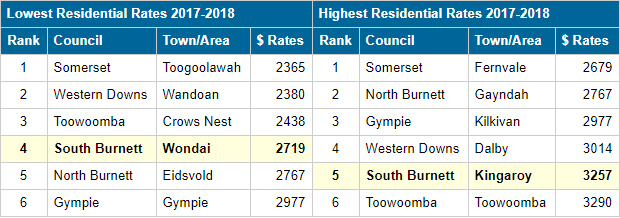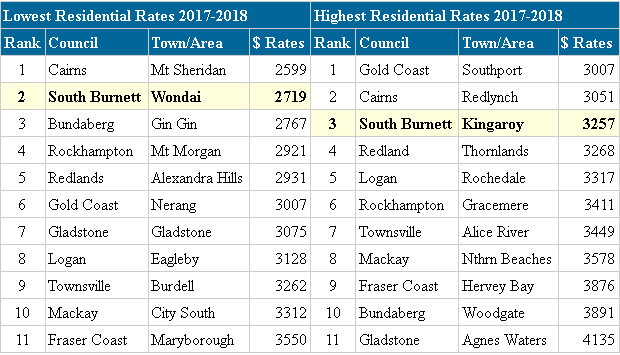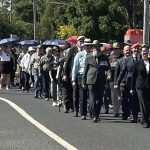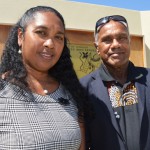
November 6, 2018
by Dafyd Martindale
Does the South Burnett have the highest rates in Queensland? Are our rates so high they’re deterring new residents from moving here?
Claims like these were made during the South Burnett Regional Council’s recent “Listening Tour”.
In 2014, southburnett.com.au carried out a study to compare the South Burnett’s rates with other Queensland councils.
For the purpose of fair comparison, we looked at the lowest and highest residential rates levied by 19 councils, including not only our immediate neighbours but also the largest councils in the State and most councils on the coast.
The results of this study surprised some people because they showed that while none of us like paying rates, the South Burnett compared fairly well.
While it is true our region isn’t the cheapest place to pay a rates notice, neither is it the most expensive.
Our study also demolished a long-standing myth that areas like the Sunshine Coast have much cheaper rates than we do.
That myth arose because in places like Brisbane, Ipswich, Moreton and the Sunshine Coast, water and sewerage services are provided by private companies and are billed separately from Council rates notices.
We found that when we added these charges in, the true picture was much different.
The information for our study was taken from standardised, State-wide rates and charges data collected by the Department of Local Government from all Queensland councils every year.
To see how our region really stacked up, we first compared the South Burnett with our five immediate neighbours (Somerset, Toowoomba, Western Downs, North Burnett and Gympie regional councils) because they have similar geography and face similar issues.
Then we compared our rates against the rates paid by Queenslanders living in 10 regions along the coast, because this where most of the State’s population lives outside the south-east corner.
And finally, we compared our rates against four of Queensland’s metropolitan councils – Brisbane, Ipswich, Moreton and the Sunshine Coast – to see how we stacked up against the biggest in the State.
We carried out this identical study in each of the three succeeding years.
So when the Department of Local Government made its 2017-18 rates data available recently, we decided to do the study a fifth time.
Here’s what we found this year:
* * *
How We Compare With Our Neighbours

In last year’s study we found that when compared with our immediate neighbours, the South Burnett’s rates were neither the cheapest nor the most expensive on offer … we were about mid-range.
Nothing much changed in 2017-18.
Wondai (at the lower end) retained last year’s fourth position, and at the higher end Kingaroy’s average residential rates bill of $3257 kept it in fifth place; Kingaroy residents are now paying $33 a year less than if they lived in Toowoomba City.
The South Burnett’s position is largely due to the annual $200 road levy, which the Council introduced in 2013 after it lost $1.4 million from its annual road funding grants in 2012.
That funding still hasn’t been restored, so the road levy remains in place – though in this year’s Budget, both the former Road Levy and the former Environmental Levy were folded into the general rate.
This will remove them as separate line items from future rates notices, but it will also change them from flat fixed charges to costs that will be indexed in future years.
* * *
How We Compare With Coastal Shires

In previous comparisons with coastal shires, we found the South Burnett was generally cheaper than most rural coastal regions in Queensland.
That remains the case this year, where at the lower end, the South Burnett came second to Mt Sheridan (Cairns Regional Council), who pipped us by $118 a year, or a little more than $2 a week.
At the upper end, the Gold Coast’s Southport and the Cairns suburb of Redlynch were as much as $250 a year cheaper than Kingaroy’s average residential rates, or about $5 a week.
But everywhere else on the coast cost more (in Gladstone’s case, quite a lot more) than the South Burnett.
* * *
How We Compare With Metropolitan Areas

Finally, it should be no surprise that the South Burnett’s rates are more expensive than the large metropolitan councils of south-east Queensland.
Two big reasons for this are that they have much bigger populations to help spread the cost, and most have much smaller road networks to maintain.
But the surprise this year was that at the lower end, the South Burnett’s cheapest rates (Wondai) are now $147 a year less than Brisbane (almost $3 per week); and at the higher end, our most expensive residential rates (Kingaroy) were just $67 a year higher than the Sunshine Coast (a little over $1 per week).
* * *
So How Do We Stack Up?
The South Burnett is in the difficult position of having a small population (about 32,575 people) which is serviced by a very big road network (about 3000km, half of which is unsealed).
Maintaining this road network is the single biggest cost the Council faces each year, and road maintenance routinely chews up close to half the Council’s Budget.
Since amalgamation in 2008, $230 million has been poured, gravelled or graded into our regional road network, something that looks set to continue indefinitely into the future.
Our road network’s maintenance costs are the main reason why our rates are as they are, but they’re not the only one.
Credit for the rest goes to our libraries, our swimming pools, our sports fields, our town halls, our parks and gardens, our cemeteries and the many other services the Council operates and maintains.
Unlike some other rural regions, the South Burnett has kept nearly all the services it inherited at amalgamation, despite the fact most of these are also a big drain on the public purse.
However, these services are important for improving the liveability of our communities – which is what attracts people to buy houses here (and grows the rate base).
Our comparisons over the past five years have shown that while we’re not the cheapest or the most expensive place to live in Queensland, the difference between us and both ends of the scale isn’t all that much, either.
* * *
Notes On Comparisons With Neighbouring Councils::
- This table directly compares the lowest and highest average residential rates levied by each of the five councils the South Burnett shares borders with using data supplied by LG Information.
- For the purpose of fair and equal comparison, the total figure shown for each Council is the Total Average Rates & Charges Per Annum figure supplied by LG Information before any rates discount is applied, since rates discounts vary from nil to 15 per cent in different shires.
- This table does not include the Cherbourg Aboriginal Shire Council because that council does not collect rates.
- Somerset Council’s water and sewerage charges are billed separately by Queensland Urban Utilities and do not appear on that Council’s rates notices, so the average water and sewerage charges for Kilcoy and Fernvale have been added to Somerset Council’s rates data to provide an accurate comparison.
Notes On Comparison With Other Regional Councils:
- This table directly compares the lowest and highest average residential rates levied by eight other Queensland regional councils, along with Logan and Redland in the Brisbane metropolitan area, using data supplied by LG Information.
- These councils were chosen because all of them supply the same mix of services (ie water, sewerage, waste collection) that the South Burnett Regional Council supplies.
- For the purpose of fair and equal comparison, the total figure shown for each Council is the Total Average Rates & Charges Per Annum figure supplied by LG Information before any rates discount is applied.
Notes On Comparison With Metropolitan Councils:
- Residents in metropolitan councils such as Brisbane, Ipswich, Moreton, the Sunshine Coast and Somerset now have their water and sewerage services supplied by State-owned corporations Unitywater or Queensland Urban Utilities.
- These corporations bill residents quarterly for these services, which no longer appears on council rate notices.
- Because of this, the figures shown in this table comprise the rates levied by each of these five councils (shown in the Department Of Local Government’s figures) plus the annual access charges levied by Unitywater or Queensland Urban Utilities (as shown on their websites)
External links:
- LG Information – 2017-18 Residential Rating introduction and Residential Rating, and 2016-17 Residential Rating (Excel spreadsheet)
- Queensland Urban Utilities (Brisbane, Ipswich, Somerset)
- Unitywater (Moreton, Sunshine Coast)
Related articles:
- Rates: How Do We Shape Up In 2017? (2016-17 comparison)
- Rates: How Do We Compare In 2016? (2015-16 comparison)
- Rates: How Do We Compare This Year? (2014-15 comparison)
- Rates: How Do We Compare? (2013-14 comparison)
























A very interesting comparison. From personal experience we purchased a property in Kingaroy 11 years ago for $207,000. The council rates at that time were approx $1200 per annum. We sold the property in June this year for $185,000 at which time the annual rates were now approx $3200. I am quite sure our pension never increased at that rate over the same period.
A comparison of some Rural rates notices issued for properties of same acreage, same unimproved values and same land use shows the Western Downs rates are less than half the rates charged by the South Burnett Regional Council. This is not just one rural resident’s experience but several. For example Western Downs charged $1500 and the South Burnett Regional Council $3300 for virtually the same article on half-yearly notices from both Councils. It was rural residents making the comparison at the Listening Tours and this article has not included rural ratings. Rural residents were definitely not coddled, perhaps slapped around would be a more accurate description.
Lorna … I acknowledge the statement about being “coddled” was offensive and should not have been published. The report has been edited and that has been removed.
It is my understanding that the rates we pay are our share of the costs of running the South Burnett region. This includes all the things mentioned in the article the largest cost being the road network. So to see a decrease in the rates we would need a lot more people to move here and build houses i.e. more ratepayers or perhaps more high rate paying industries i.e. mining and power generation as they have in Western Downs region. I like living in a smaller community and the issue of mining and power generation has met with quite a lot of resistance so if you don’t want these things your share will stay as it is. We could perhaps give the council other income streams i.e. paid parking as in larger towns or fees to dump your rubbish again as in larger towns. No? Everything has to be paid for and it seems that some people want all the services and more but think someone else should pay for it.
Local Government, together with State Government, should immediately promote (via TV, Radio, Social Media) all areas that are within a couple of hours of Brisbane, the Gold and Sunshine Coasts to hopefully target the population of Brisbane (which shall shortly burst at the seams and be hopelessly over-populated) in order to ‘spread’ the populace a bit more evenly.
The State Government could start this exercise by moving a couple of large Departments into a regional area. We (all of us!) should be doing what we can to build towns so that progress can continue, however the short-sighted leaders we have do nothing, as towns slowly but surely grind to a halt whilst rates, charges etc rise to unexpected levels for folk who moved to ‘the country’ for a quiet and affordable life.